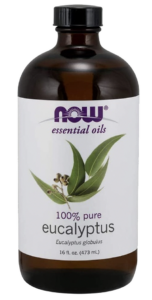Covid Recovery Blog

LISA ORLANDO
Licensed Acupuncturist, Dipl. Ac.
Former Producer-Editor 60 Minutes (CBS), CNN, CNBC, NBC
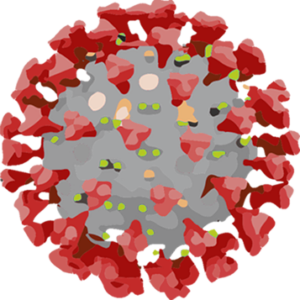 Working for CBS NEWS/60 Minutes in the early days of March 2020, we were one of the first clusters in NYC to get Covid-19.
Working for CBS NEWS/60 Minutes in the early days of March 2020, we were one of the first clusters in NYC to get Covid-19.
Here is the blog I kept throughout my quarantine and convalescence with home remedies, meditations, foods and the Chinese Medicine that helped me recover. Please share with those who may benefit.
Post #1
3/26/2020
–
My friends — I am well into the third week of quarantine with a positive coronavirus diagnosis. (Several of us CBS colleague took a hit.) There is much that we will learn about this wiley opponent in the coming months and I hope to be sharing more as we go. For now, I wanted to pass on one of the home therapies which has made a difference in my recovery.
–
Many of the good quality essential oils (I like NOW brand EUCALYPTUS, available at Whole Foods) are natural anti-virals. Eucalyptus is an anti-viral, an anti-bacterial, an anti-fungal, a decongestant AND an anti-inflammatory. You may want to keep a couple bottles handy in your Medicine cabinet especially in the winter months. You can sprinkle a few dashes of Eucalyptus oil in a pot of water, bring it to a simmer, stand over or pull up a stool and let the steam soothe and open your sinuses as it kills off the virus. You can also sprinkle some in your bath water. Or apply some to your chest during a shower. It’s a strong oil, the essence of the plant. So avoid direct contact of undiluted oil to face and eyes as it may cause irritation.
–
–
Now Foods : These statements have not been evaluated by the Food and Drug Administration. These products are not intended to diagnose, treat, cure or prevent any disease. Please check with the manufacturer regarding warranty and support issues.
–
Post #2
3/27/2020
–
A New Yorker article states that a person with the virus can shed it or pass it on for up to 37 days. [See 12/2020 CDC website update at bottom.] All this is to say that you might think you’re done with this virus once you start feeling more human, but likely you’re not done. The folks in the ER that treated me, said I needed to be symptom free for 3 days before I could consider myself no longer contagious.
–
And we can’t forget about that tell-tale symptom of coronavirus: a-NOS-mia (a little humor here) aka loss of smell. You can have only that symptom and nothing else – no shortness of breath or fever, etc. That symptom alone is enough to make it possible to pass on the virus.
–
I haven’t been able to smell a thing for 2 weeks.
–
When I put my nose over my morning espresso (usually one of my favorite moments of the day) I get nothing but a sensation of heat. It’s unnerving. I deal with a good amount of numbness due to treatment for Lymphoma over 20 years ago, and not being able to smell is akin to dealing with an inactive or numb limb. Or not being able to experience depth perception due to only one working eye. I have the sense that we navigate in part by our sense of smell, the way animals use radar. Of all the symptoms of this virus, this is the easiest to manage as it isn’t painful like so many of the others. But it’s important to monitor it for your contagion factor.
–
It was my experience that symptoms lasted in general, much longer than with a cold or flu. And if we’re not vigilant in keeping up on our therapies and healing regimens (more on that later) a symptom that you might have thought was gone for good, can return. I had that happen with the coronavirus with several symptoms such as congestion, shortness of breath, and body aches.
–
I keep thinking of what Jeffrey C. Yuen, the Dean of our Acupuncture Program at the Swedish Institute said about any life-threatening illness: it’s a full time job. You need to change over your day and your life so that every aspect of it is devoted to healing the problem at hand. There’s a way to do this so that it’s not depressing to you and others. You can be vigilant about your wellness without being precious. Rather, your healing and the priority you make it can be a shining example to all. Chances are others you know are challenged with their own health challenges or maybe even this virus.
–
So bottom line: it ain’t over till it’s over. Thankfully for many of us, the world has slowed down enough to allow this vital healing to happen. Having the time to heal can be one of the silver linings of this pandemic.
–
CDC website update as of 12/20/20: Available data indicate that persons with mild to moderate COVID-19 remain infectious no longer than 10 days after symptom onset. Persons with more severe to critical illness or severe immunocompromise likely remain infectious no longer than 20 days after symptom onset. Recovered persons can continue to shed detectable SARS-CoV-2 RNA in upper respiratory specimens for up to 3 months after illness onset, albeit at concentrations considerably lower than during illness, in ranges where replication-competent virus has not been reliably recovered and infectiousness is unlikely.
–
Post #3
3/28/2020
–
One friend asked me if at any point I felt like I was fighting for my life? I definitely had moments where I wondered how I was going to make it through. And some of us afflicted with this virus have come face to face with mortality.
–
Something I learned from having had a cancer dx is this: I question if the fighting metaphor when it comes to illness is apt. I think a more helpful way to think of our answer to illness is as work. Hard work. As in, “there’s a lot to clean up here and I’m on the case!” Everyone understands hard work where it’s all hands on deck. Certainly our bodies do. Look at the hard work necessary in birth, not just for the mother but the child, too.
–
Fighting, for me, is too abstract. There’s that element of fear implied as in “will I make it?” You don’t need that. It’s a dramatic distraction suitable for operas! For illness, I question if we can spare the time and resources when there’s work to be done.
–
Throughout the first 2 weeks, when the virus felt the strongest, I was in what I’d call a healing state. While I was aware of the difference between the nights and the days, there was a sense of timelessness. My progress couldn’t be measured in days like a normal respiratory illness, but rather in weeks. So keep that in mind as you weather through this, or advise anyone who is. Don’t be surprised if time feels as if it has slowed down. And this situation of quarantine and sheltering-in–place where the world seems to have come to a grinding halt – the sick may need it to heal. We all may need it to pray.
–
To my surprise, prayer has come easily at this time. When you are really sick, you have to take the hard work to the cellular level. Whether you call it an inner journey, a meditation or a visualization, this is a time to direct the healing process. While I was dealing with fever and feeling overcome with illness in my lungs, sinuses, and nasal passages, I found myself silently addressing the virus itself, “What is your nature?” You may not get an answer right away, but it will come. Let your body study the virus. That’s how it will come up with the response required to overcome it. The “invisible enemy ” metaphor can be overwhelming because it implies that it’s unknown. But you can know it. You can know it in a deep way where there are no words to define it. You can know it enough to heal.
–
Post #4
3/29/2020
–
In the last few days, I’ve felt well enough to delve into my Chinese Medical texts to see how I might be able to treat myself. To be honest, throughout the worst of this illness, I just didn’t have it in me. [In the spring of 2020, no acupuncturists were treating patients. That didn’t happen until July.] I was however able to successfully treat a raging sore throat that I worried might be serious. It went away immediately. But that was all the energy I had to devote to giving myself acupuncture treatments. Too busy making antibodies, I guess.
–
But I kept thinking how sad that a Licensed Acupuncturist can’t lend herself a helping hand when she can’t see an acupuncturist.
–
But today, I had the focus to open my texts and contemplate the Lung Channel which we say “opens to the nose” through its connection to the Large Intestine Channel. I studied the point next to the side of the nose YING XIANG aka LI20 – WELCOME FRAGRANCE. It treats loss of sense of smell.
–
People often ask me the reason I got a Master of Science in Acupuncture at mid-life. There are too many to list but the poetry of the point names pulled me in. Not just the poetry, but the science. To have a medicine with point names that tell you exactly what they do (plus a whole lot more beyond the name itself), this intrigued me.
–
Google led me to this case study from 2010 with a point combination to restore the sense of smell. I’m including it below for the acupuncturists amongst us who are curious.
–
I also included SHUI GOU (DU26 – NOSE HUMAN CENTER) located just under the nose on the philtrum. It’s able to treat “the inability to distinguish the fragrant from the foul.” That’s different from loss of sense of smell but I wanted to include it. As I wrote previously, without the sense of smell, I have been unable to connect to the things I know. To “grok” them. Indeed, there’s a certain loss of humanity, if you will, without the sense of smell which helps us differentiate and make decisions. The world can be a dangerous place without it. AND it’s a tell-tale symptom of the Coronavirus. This symptom alone, meaning no other observable symptoms, can mean you are contagious.
–
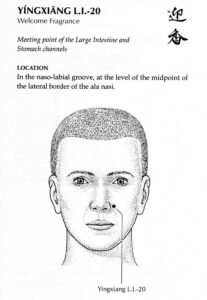
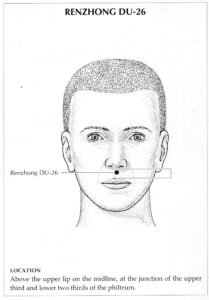
EUREKA! I am thrilled to report we have contact! First, I was able to smell the handsoap as I prepared to make dinner, then the toasted sesame oil warming on the stove. I knew when to turn down the flame before it started to burn and add in the grass-fed meat at just the right moment. And when dinner was ready, the fragrance was never as welcome!
–
Another reason I wanted to study Chinese Medicine: it works. I wish I could have treated myself sooner, but alas, I accept that I needed to direct my attention inwardly at the beginning in order to think straight about acupuncture. We get the job done however we can.
–
Once I test negative, perhaps I can treat you (for lack of sense of smell and/or whatever ails you). Have Corona immunity; will travel! That should be any day now; I can smell it.
–
2021 Update: for those of you who are comfortable performing acupressure on yourself, I encourage you to try the treatment in the case study with essential oils. Eucalyptus seems like a good option. Put some eucalyptus oil on your finger tip (diluted with coconut oil because the face is sensitive) and press in firmly until you feel the connection and something starts to shift.
–
Diagrams of Acupuncture points are from “A Manual of Acupuncture” by Peter Deadman.
Post #5
3/30/2020
–
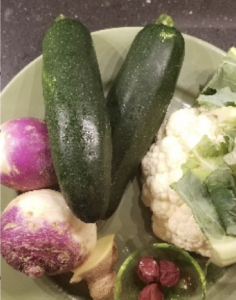
–
For the first weeks of the virus, the only thing I wanted was this light, hydrating, easy to digest soup. Later on, I wanted other foods but it’s still my favorite go-to option during convalescence. I’m brewing up a new pot now and am sharing the recipe with you on the fly. Everyone has their own favorite recipe but here are my ingredients and why. (*Deep thanks to my 60 Minutes colleagues Magalie Laguerre-Wilkinson and Michael Karzis for delivering groceries to my door when I was in quarantine.)
–
–
INGREDIENTS
–
♦ Bone in chicken thighs: dark meat is more moist than white. And the bone adds that much more moisture and minerals. With the fevers you may have experienced, and the decongestants you may have taken to treat the sinuses (*special thanks to Larry Johnson, Mimi Quillin, and Emily J. Orlando for delivering OTC items when my neighborhood stores were sold out) you need to restore the moisture. White meat just doesn’t cut it.
♦ Zucchini: when they’re as large as the one in this picture, 1 is plenty. Smaller zucchinis are sweeter and less tough. Also moisturizing.
–
♦ Turnips: an excellent moisturizing root vegetable. Smaller is better.
–
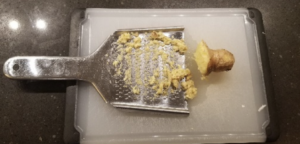 ♦ Fresh grated ginger (about the size of your thumb) to tonify the body: you can purchase a Japanese grater like this online. A standard cheese grater is not so good and ginger is too fibrous for a garlic press. You can also use it to make homemade ginger tea.
♦ Fresh grated ginger (about the size of your thumb) to tonify the body: you can purchase a Japanese grater like this online. A standard cheese grater is not so good and ginger is too fibrous for a garlic press. You can also use it to make homemade ginger tea.
–
–
♦ Cauliflower: an amazing vegetable that’s getting new appreciation every day. Cut in thin slices. When it cooks down, it makes a natural thickener and it’s a great rice alternative that keeps the soup light. You may not have the stomach for heavier, starchier foods, and you don’t need to tax your system when it’s busy at work with the virus clean up.
–
♦ Umeboshi plum: the secret ingredient. This is the pink paste you see in sushi, a picked sour plum which aids digestion. I used 1 in my pot.
Simmer for 30 minutes or more. You want the ingredients to be soft and full of fluid, even close to mushy. The chicken should be stringy, falling off the bone. That’ll make less work for your digestive system and renders the nutrients more accessible. Garnish with your favorite rock salt.

Post #6
4/4/2020
–
We think our group at 60 Minutes became infected with the virus on March 4, so it’s about 1 month since I’ve been dancing with the coronavirus. I’m beginning to think of the parade of symptoms like characters in a play. Some have thankfully come and gone while others have remained on stage or returned as major players. If respiratory issues is the star, then fatigue is the award winning supporting actor. For many, fatigue is the persistent player that lingers.
–
We know that if one is experiencing significant shortness of breath with this virus, it’s time to call 911. I did and I’m grateful that on the prompting of colleagues, I was taken to St. Luke’s Mt. Sinai hospital where they administered a nebulizer treatment for about 2 hours. It was effective enough and the ER staff told me that I’d be safer at home. (*Special thanks to my CBS colleagues Dr. Jon LaPook, Claudia Weinstein and Nieves Zuberbuhler for their calm but insistent phone calls guiding me to take the necessary action when I couldn’t counsel myself.)
–
But there’s a lesser, related symptom — breathlessness and fatigue — that I’ve been experiencing in the recovery phase.
–
I noticed on several occasions this week, while lying in bed or sitting, that my breathing was shallow. I wasn’t able to take in a full deep breath. In Chinese Medicine (CM) the sensation of Qi arriving (essential in the breathing function) is likened to “a fish biting on the end of a hook.” Well, this fish wasn’t biting. It felt as if my breathing wasn’t anchored.
–
CM talks about the vital connection between the Kidneys and the Lungs. If the Kidneys can’t anchor the breathing in the lungs, then the breathing will be shallow. I’ll keep the textbook quote brief here but I think you may find this helpful in understanding the complexity of fatigue. Or feel free to skip to the next paragraph! “If the Kidneys are weak and their function of reception of Qi is impaired, the Kidneys will fail to hold Qi down and Qi will flow back up to the chest. This obstructs the Lungs descending function and causes breathlessness (more on inhalation), cough, and asthma.” [“The Foundations of Chinese Medicine”, Giovanni Macciocia]
–
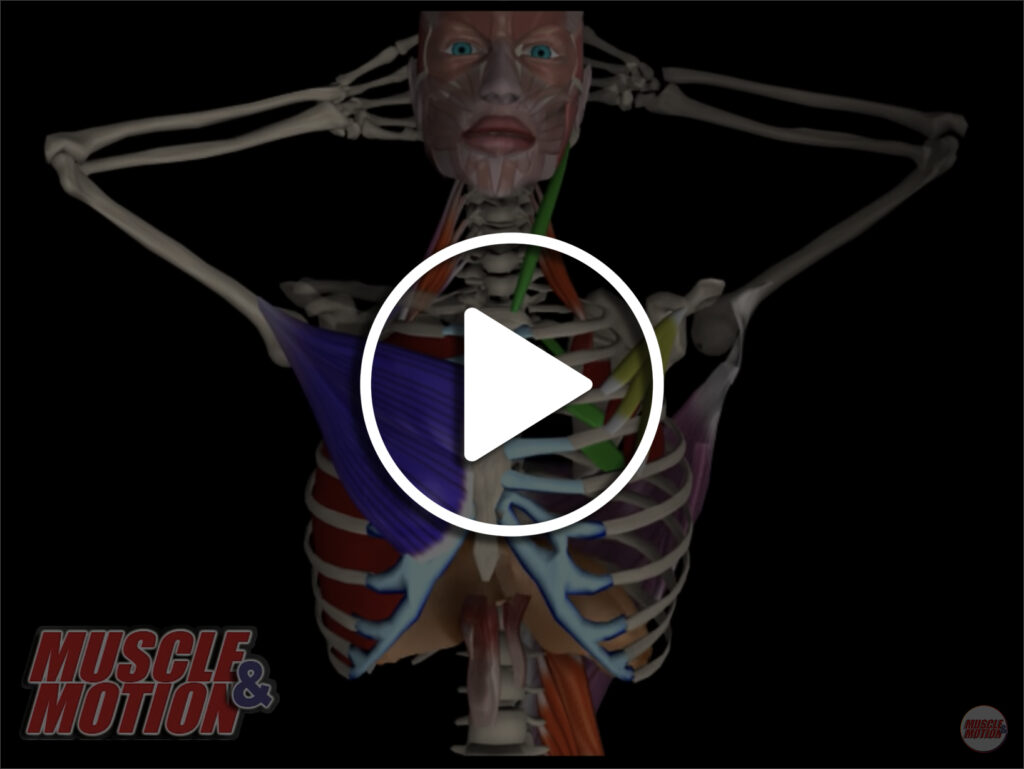
–
You may be surprised to learn that western medicine has the same understanding of the lung-kidney connection. The diaphragm, known as the breathing muscle, regulates the lungs. It’s lowest attachment is the lumbar vertebrae — in other words, at the level of the kidneys.
–
Watch: Muscles of respiration (inspiratory muscles)
From Muscles in Motion.
–
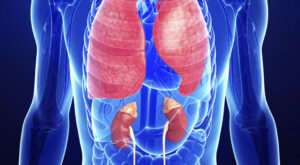
––
In this illustration from the Cleveland Clinic, you can see the proximity of the lungs to the kidneys. The adrenal glands sit atop the kidneys like a triangular hat. In Chinese Medicine, the kidney organ/Kidney Channel and the adrenal glands function as one unit and are referred to under the umbrella term of “kidney.”
–
When the Kidneys which have to do with stamina become exhausted, they can’t do their job of anchoring the lungs and the breathing. And of course, having the coronavirus itself exhausts the Kidneys. Those first two weeks, I didn’t sleep more than a couple hours here and there due to upper and lower respiratory issues. For many days, I couldn’t sleep while lying horizontal. On top of lack of sleep, my whole frame was exhausted from the Herculean effort of pushing out the virus pathogen.
–
So that fatigue you feel when you’re “better, but not well” is not only significant, it may be extreme. This is no ordinary tiredness. It’s what’s referred to as Yang Collapse. You may not feel you have the Qi or the energy to literally lift a finger, or to talk on the phone. Even walking across the room may be an effort. That requires a baseline of lung power that you may not have regained yet. You will. You may have a burst of energy one day and think you’ve vanquished COVID-19’s sorry ass only to find that the next day, you crash. This happened to me a lot. And if you’re a person who’s used to being active, you may feel somehow incompetent, a liar even because you were sure you were done it feels like you’re back at the beginning. To add insult to injury you may have well–meaning friends who check in and ask “so, are you better yet?” The extreme fatigue you are experiencing may seem like an inconvenience to your friends and family.
–
I’d like to recommend you put aside that thinking. This is – as I wrote of in Post # 3- where the fighting metaphor doesn’t serve you. Fighting fatigue serves to exhaust you further. And you’ve already been through the wringer — a very apt description of the muscle aches that I experienced with this illness. (More on muscle aches in a future entry.)
–
So in terms of recovery, it takes what it takes. You can’t hurry love, as the song goes. Same thing with healing.
–
Getting back to idea of Qi arriving — just today, when I take in a breath, I’ve been able to feel that little fish biting the end of the hook. It’s a full anchored breath thanks to the restoration of the Lung-Kidney connection. It’s probably why I was able to write a new entry today. I’m not sure how long that Qi fish will stay or if he will wiggle off the hook. But so far, so good.
–
Post #7
4/10/2020
–
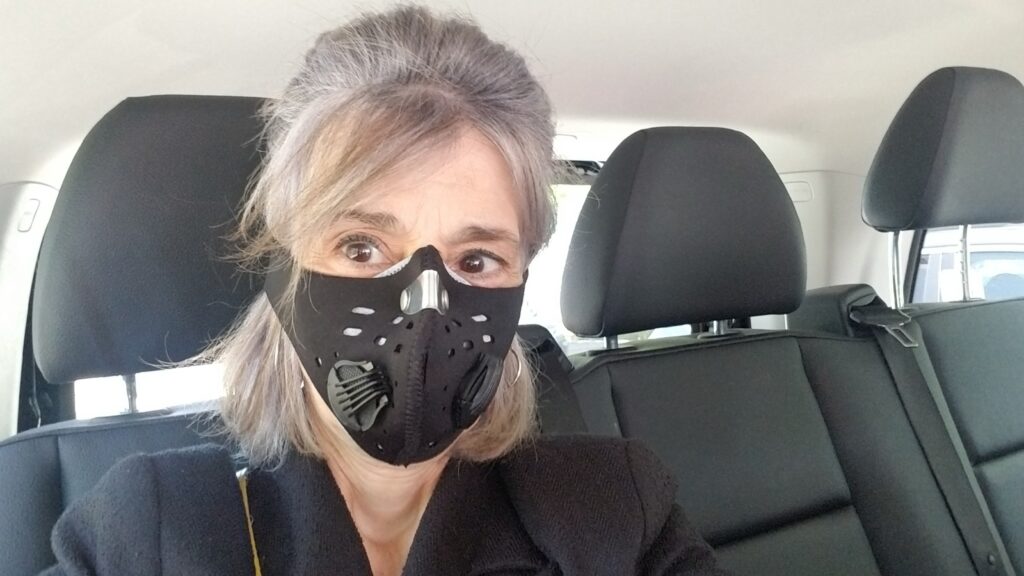
It was my maiden voyage out of the house since the visit to the ER. At the time, you couldn’t purchase cloth face masks and N95s. The only thing I could find online was this biker mask with vents which has since been proven to be ineffective against the virus. Friends nicknamed me “Darth Lisa.”
–
The moment I walked through the doors of Mt. Sinai’s off-campus building on East 102nd a handful of professionals, men and women evenly spaced (*the term “socially distanced” hadn’t come into existence at the time of this writing) ushered me toward their fold-out table. Their eyes seemed all the more compassionate when peering over their masks. These were the essential workers, I thought, who are cheered every night at 7pm by New Yorkers from their windows. It goes on every night for a good 3 minutes. Since I hadn’t had the lung power to cheer nor the fortitude to lift my heavy window, I took the opportunity to thank them in person for their service.
–
I had an appointment to have blood drawn to see if I’d developed enough antibodies over a month’s time to donate to others and hopefully help them overcome the disease. As one nurse asked me questions about my symptoms and the lack of them, another checked my ear temperature — normal — while another clipped a pulse oximeter to my fore finger. “I’ve got one of those little things at home,” I told her. My blood oxygenation level was as good as ever. Even in the ER weeks earlier, it was an impressive 98 — normal being between 94 and 99. Then the nurse eyed the device sternly, “Well I don’t like that at all. Your pulse rate is 30.”
–
“That can’t be right,” I said, a little embarrassed. “There must be something wrong with the darned thing.” When I’d checked my levels previously at home, I’d noticed it takes a few moments to warm up to get my reading. For an adult my age, the average heart beats per minute (bpm) at rest is around 70 – 100. But a reading as low as 30 made me panic. Within one very long minute, the pulse rate climbed to 80. “That’s better,” she said. “You can take the elevator to the 7th floor,” she said ignoring the glitch and pointed behind her.
–
The blood draw was relatively uneventful and Dalia, the practitioner, said they’d call me within 48 hours. Still waiting to hear back.
–
The next day, which was yesterday, I asked my acupuncturist Libbie Rice, the former Chair of the Acupuncture Program at the Swedish Institute (who inspired me to study Acupuncture) if she’d consider a virtual acupuncture session. I hadn’t had a treatment with Libbie in 2 months (way too long when one is sick) but I was in quarantine. Although I’d been treating myself, there’s nothing like getting a treatment from the mentor who’s taught me most of what I know about Chinese Medicine. I wanted to get her opinion on the lingering symptoms I’ve written about. I’d feel pretty good one day, then relapse the next with fatigue and what felt like new congestion. This pattern had gone on for several days. My chest was tight. There was pain upon inhalation. I heard Chris Cuomo who contracted the virus after me and was broadcasting updates from his basement, describe that same symptom: tightness in the chest.
–
Libbie, bless her, was happy to help. I’d do the intake (pulse and tongue reading); she would devise the treatment plan and I’d do the needling.
–
While taking pulses is part of every acupuncture session, I hadn’t taken my own since school. I was expecting the even rhythm I always feel when I place my fingers in position along any patient’s wrist. To my shock, it was irregular, quite irregular: a beat here and there, then 3 even beats, then a skipped beat, then 2 double time. It’d never encountered anything like it — not in my clients, nor at the school clinic. Nothing you could sing along to, that was for sure. It reminded me of the uncertain rhythm of a severely drunken person as he staggered down the street. Alarmed, I pulled my fingers away not because I was worried but because I didn’t recognize it as the pulse that I knew.
–
I took out my pulse oximeter, one of the get-well gifts from my colleague Ann Silvio. I wanted to see if it would verify the intake I’d done on myself. The bpm was low: 42. Again, it hung there for a minute or more before creeping up to a normal 82. That’s the moment, I realized that the initial low reading with the nurse at Mt. Sinai was no device malfunction. Practitioners are trained to see patterns and I knew something was up.
–
More fascinated than worried, I emailed Libbie both the western and eastern pulse readings. She got back to me soon enough with details for a very simple acu-pressure treatment using pressure, not needles. She’d decided on just 3 points to press.
–
Here was her treatment plan:
–
“What jumps out at me is a confused heart Qi. The beat of the heart is all over the place – should I speed up? Should I slow down? The virus itself attacked your lungs and the lungs determine the heart rate. So the first part of the treatment will be to regulate Lung Qi and reassure the Heart. Press deeply into Lung 10 and breathe rhythmically. As you do that, let the heart know that all is well…”
–

Take a look at where that point is situated on the body. LUNG 10 – YUJI – FISH BORDER is on the thumb. The point was so named because this fleshy part of the hand reminded the ancient Chinese of a fish belly that was resting against the border of the bone. [Note: ancient physicians often saw parallels between the bodies of animals and humans. The root of the word muscle is “little mouse.”]
–
This point clears heat from the lungs — a common symptom of the virus. She chose this point because it’s what’s called a “fire point” and she wanted to Treat fire with fire so to speak, to address the inflammatory cytokine reaction that can destroy lung tissue and calm it down with an adequate anti-inflammatory response.
–
This point also harmonizes the lungs and the heart. As one ancient text put it, “The Lung and the Heart are mutually connected, thus when there is Lung heat it most easily enters the heart.” Both eastern and western medicines recognize the interdependence of the heart and the lungs. You may have heard stories from EMT workers and other medical professionals on the frontlines of this crisis about patients dying of cardiac arrest before they get to the hospital or on a ventilator.
–
I was in no danger of cardiac arrest, thank goodness, but my heart rhythm was out of whack due to the toll the virus had taken on my lungs. I didn’t feel any breathlessness in those moments when the oximeter displayed the low readings of 30 and 42, but I did experience the sensation of jet lag later in the day. I was a person who worked out 5-6 days a week; now I couldn’t handle a flight of stairs without getting winded.
–
When I pressed on this point, it was sore as if the flesh was glued to the bone. As I was massaging the left thumb, my left eye began to twitch. In Chinese Medicine (CM), we would explain this as wind — wind that had entered the body, looking for a release through one of the upper orifices. In fact, the coronavirus is wind or an air-borne virus. It travels through the air. That’s how we become infected. I massaged the fleshy part of my thumb until the eye twitching stopped.
–
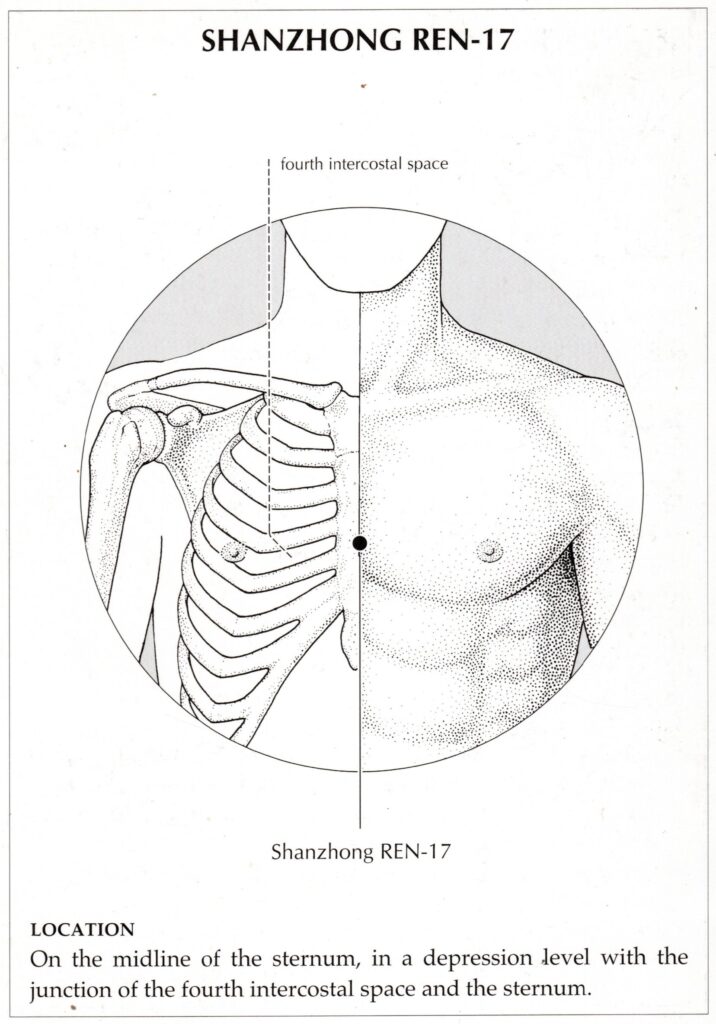 –
–
So far, since last night’s treatment, I haven’t had any low pulse rate readings. I was able to get farther along in my workout than before. I was able to perform a ten-minute series of Qi Gong breathing exercises. Yesterday, merely screening them online was exhausting. I give LU-10 a hearty thumbs up!
–
–
The second point Libbie included was REN 17 – SHANZOUNG – CHEST CENTER to address the pericardium.
The pericardium is the sheath around the heart muscle which can tighten and squeeze the heart and cause pain. This point “opens the chest.” After I massaged this area, the tightness and pain subsided.
–
–
Come to think of it, I haven’t experienced chest pain all day.
–
That’s the nature of pain, my first acupuncturist Ken Kobayashi taught me. People notice when it arrives but they don’t notice when it disappears. (I’ve come to see that ironically, this is one of the reasons acupuncturists often aren’t given the acknowledgement they deserve. They help make pain go away and no one notices pain when it disappears.)
–
This point also treats insufficient ability for speech. Some friends thought I was avoiding the phone because it was painful to talk, but it’s more basic than that. I didn’t have the lung power. It’s a matter of weakness, not pain.
–
This point is key in treating the immune system and in CM it is the immune system aka the Wei Qi which the Lungs oversee. The Wei Qi in turn regulates the heart rate. So there’s the Lung-Heart connection again.
–
It’s a lovely treatment that you can try safely at home. And because it is just 2 points on the body (a total of 3 because LUNG 10 is done on both sides), a simple triangle formation. So basic, you may question its effectiveness. The last thing you want to do to a patient who is overwhelmed with exhaustion, is give them a treatment that exhausts them further. This is something I’ve learned first-hand during this illness. You can’t clobber this virus with too much treatment, too much to do, when the host’s immune system is already on red alert. Less-is-more has never been more appropriate. So keep it simple whether you are treating yourself or caring for others who are ill.
–
It’s just about 7pm and I’m going to stop now to open my window and join in the nightly shout-out. Thanks to the folks in the ER and to Libbie Rice. I expect my performance will be as cheery and heartfelt as my neighbors.
–
Diagrams of Acupuncture points are from “A Manual of Acupuncture” by Peter Deadman.
Post #8
4/25/2020
–
One of the symptoms you hear coronavirus patients talking about is the cough – the dry cough that isn’t productive meaning no phlegm, or very little comes up. That repetitive cough is the body’s way of trying to clear the pathogen out but often due to the accompanying fever, the lungs and throat are just too dry to do it. And that unproductive cough can be exhausting. At one point the muscles in my ribs were so taxed from dry coughing, they were sore.
–
My cough didn’t become productive until after the first 2 weeks when the fever was no longer constant. And when the phlegm finally did start to come up, it wasn’t pretty. It was unusually dry and all colors of the rainbow. (Although acupuncturists are fascinated by phlegm and all the diseases it causes, I’ll leave out the details for the general audience.)
–
Pears are excellent to address the dry cough of coronavirus or any virus because they moisten and clear heat from the lungs, throat and mucosal lining and help to expectorate mucus and phlegm. They are moist because they have more soluble fiber and hold onto water better than other fruits. Apples are also good but pears are juicier.
–
During my convalescence, I learned a lot about how to get the juiciest pears and it’s not as simple as you think.
–

First, if you can find them, you want to buy ripe pears. I like Bartlett pears because they are particularly juicy. Asian pears are also juicy but they’re expensive and they don’t get soft like Bartlett pears. They should be golden or on their way to golden. Sometimes all you’ll find at your market are hard green pears. Sadly, I had to throw out too many pears (about 10 so far) that never ripened. If they have a rubbery skin — different from a juicy ones that you can pinch — it’s likely that they’ll never ripen. Besides the other benefits of buying organic, I find organic pears are more likely to ripen perhaps because of the picking schedule. It’s not worth it to buy a cheap pear if you have to throw it out.
–
You should be able to press your thumb into the skin and it should give a little.
–
If there’s no give, or it’s rock hard, there’s no guarantee it’ll ripen. Even if they have that give, they may still need a few days out of the refrigerator (see photo) to ripen. Because you’re eating so many in a week, there may be a lag between buying and being able to eat them so you have to plan ahead and keep the “harvesting” process going.
–
You can also steam your ripened pear, or boil a few in a little water with fresh grated ginger and after cooked, add raw honey or agave. The heat helps loosen the phlegm that much more. You never want to eat a cold pear out of the refrigerator. Not only does it not taste as good, the cold works against the loosening. Be forewarned, cooking won’t render an unripe pear soft. I tried. Best to throw it out if it stays green for days without a change in color or softness.
–
There are some normally healthy foods that are contraindicated in Chinese Medicine if you have a dry cough, foods like shrimp, seeds, and bone broth. These foods support the constitutional level meaning they strengthen the most interior level of the body (for instance, in the formation of bone marrow).
–
Expelling phlegm is something that takes place on the surface on the body, or the exterior — the last place before you say good-bye to it for good.
–
So, choose foods like juicy pears that help bring phlegm to the exterior and make your cough productive.
–
Note for people who are relying on other shoppers: there’s a little bit of a learning curve to picking a good pear. Let’s face it, some of our dearest friends don’t know a zucchini from their elbow! So by all means, send them my post. For online shopping services like Instacart, I add in the comments section to “please pick pears that are golden and a little soft to the touch” and that’s seems to be working.
–
Sadly, I have not had good luck with Amazon Prime Now/Whole Food online service because there’s no way to add a note.
–
So when I’m in need of pears, I don’t use Amazon Prime.
–
Post #9
4/30/2020
–
You may have heard that the CDC added some new symptoms this week to its list of tell-tale Covid-19 symptoms. Body aches is one of them. Many people with the virus are experiencing body aches aka muscle aches. For me, this symptom along with the fatigue lingered long after the upper and lower respiratory issues and the fever. Although body aches are not life-threatening, these can take your breath away.
–
Just a few days into the illness, I had my first experience. I have had the seasonal flu just a few times but this was nothing like those muscle aches. The pain started as an intense stiff neck which progressed to the whole body. The pain would come and go but at its worst — I remember telling my dear friend and colleague Claudia Weinstein, it felt like my arms and legs were being “wrung out like towels.” The pain wasn’t just upon movement; it was when I was laying still in bed.
–
I think I hear you thinking, “Oh, she’s over dramatizing.” Actually, I go out of my way not to be dramatic. Maybe it’s because my grandmother was an opera singer. Or maybe it’s because I work in broadcast news, I’ve learned that when you have an emergency of any size, hyperventilating makes it worse. Staying calm yet finding an accurate simile or way to describe the problem to an MD or a practitioner is a good way to start. You have to find a way to let them see what you’re feeling.
–
“Maybe you should take some Tylenol,” Claudia diplomatically suggested. I was so busy putting out the fires in the upper and lower respiratory that it didn’t occur to me. And that can happen with this illness: there’s so much going on at once, you don’t know where to turn first.
–
I took Tylenol that night and a couple more times but the limb wringing returned again and again. I don’t mind taking OTC pain killers in emergencies but the problem wasn’t going away.
–
Even though it’s not an NSAID like ibuprofen – which is contra-indicated for this virus — it can damage the liver. Tylenol was masking the symptom but it wasn’t able to keep it from returning. It wasn’t until the start of the third week that I was able to attempt a modified workout. (I was down for the count the first two.) Even simple physical therapy stretches in bed were painful when they shouldn’t have been. This wasn’t simple stiffness; my muscles felt locked in place. [*An acupuncture colleague told me recently that this is a condition that he’s seen in coronavirus patients called “Limbic Bi” or pain in the limbs. It happens, he said, when the body can’t or hasn’t fully been able to sweat out the pathogen. So it settles in the limbs, away from the vital organs of the torso.]
–
As I was working out, I remembered that I’d stopped taking Magnesium when the coronavirus GI issues hit that first week. I had thought at the time that the Magnesium might be exacerbating the relentless diarrhea. It certainly can, if you’re taking too much of it. Magnesium assists in muscle relaxation; potassium in muscle contraction. I’ve taken magnesium for years and it has vastly improved my flexibility. But I’d stopped taking it and forgot to add it back. Once I resumed taking magnesium, the pain at rest stopped within a day.
–
But I was still experiencing severe pain upon movement. Walking to the bathroom or kitchen was a trial. I knew that my difficulty was not due to weakened lungs or fatigue. This was a neuro-muscular issue. [*We now know that besides attacking the lungs and respiratory system, and the heart – Covid also attacks the neuro-muscular system.] Each week it seems we learn of new symptoms and another system it can attack.
–
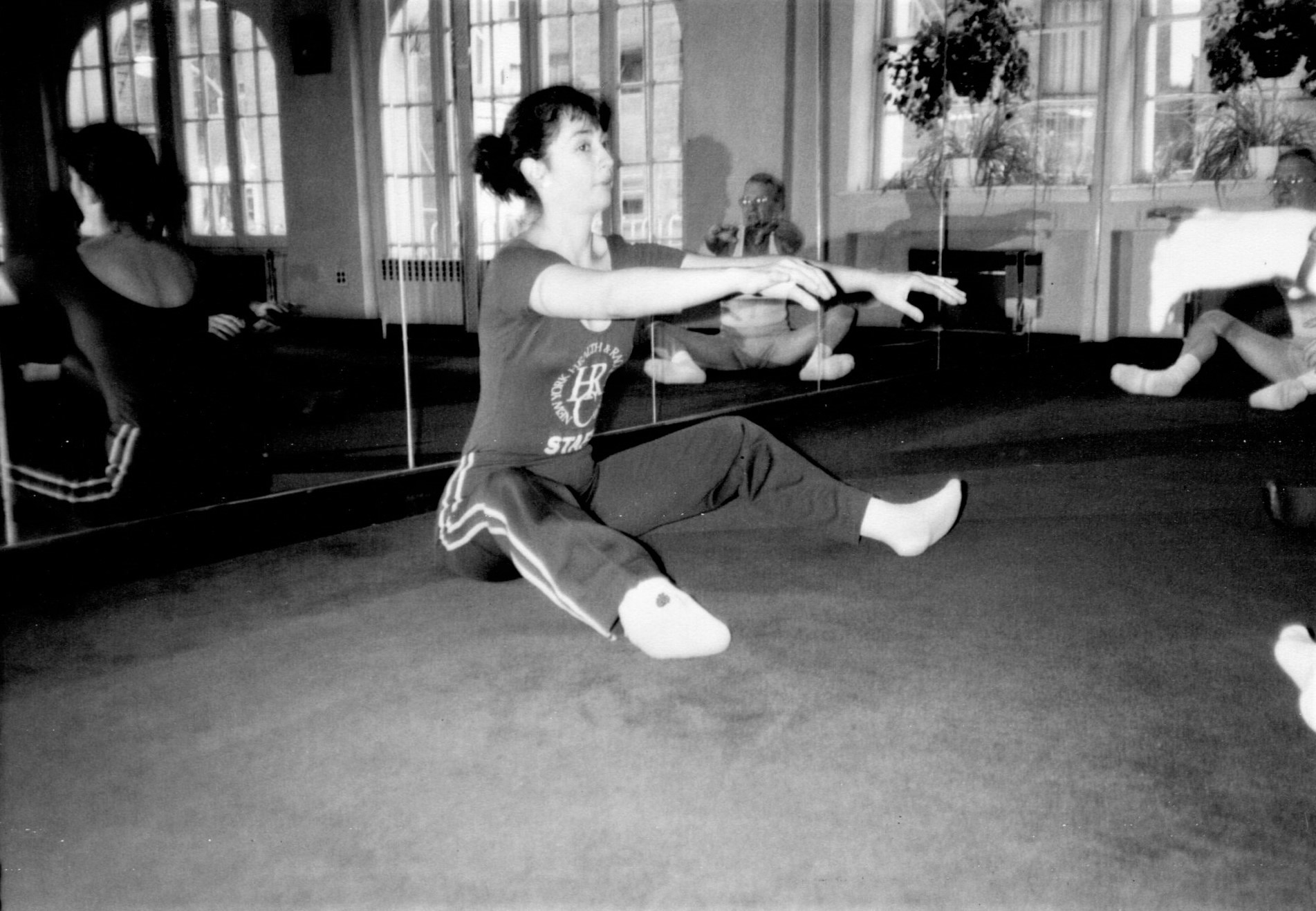
–
On another day while I was working out, I remembered that I’d gotten a tip about using lecithin to enhance flexibility when I was a young dancer. After taking a tablespoon of it a day for about a week, I was teaching a yoga class and went to perform a forward bend in a straddle position – not my easiest posture. Instead of the usual resistance, I had such flexibility that my head lightly tapped the floor. That was a first! A dancer never forgets an advantage like that.
–
Lecithin is a fat and an emulsifier that’s found in foods like soy and eggs. It’s an ingredient in ice cream and chocolate. Although lecithin isn’t FDA approved, it has been recommended by holistic practitioners to lower cholesterol, to treat Parkinson’s disease, to lower stress, and to improve GI function to name a few.
–
–
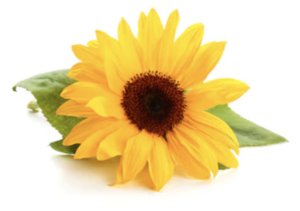
Libbie Rice, my Lic. Ac., colleague and friend turned me on to sunflower lecithin. It doesn’t have the adverse side effects of soy-based lecithin and it tastes good as opposed to disgusting. I have found the NOW brand Pure Powder to be far superior to others.
–
Something amazing (would it be too dramatic to say ‘miraculous’) has taken place since adding magnesium and lecithin to my covid recovery. Within a few weeks, I feel an inter-connectedness between head, torso, and limbs. That star-fish effect, I used to call it in my dancing days. My flexibility is closely approaching the level I had as a dancer. I was able to do a plow and a shoulder stand, not all at once mind you, but over a succession of days. This is something I haven’t attempted in well over a decade be it due to the adverse effects of sitting in a chair over time, a past spinal cord injury, or what have you. [Notice I didn’t say due to age. A 90 year old Qi Gong master is in better shape than a teenager who gets no exercise.] The spinal cord is talking to the muscles and the conversation couldn’t be happier. [Update: 8 months later, I can now get my chin to press into my chest in the shoulder stand. The pain subsided right away and the flexibility in the posture continues to improve.]
–
For those of us working at home or sheltering-in-place, now is an opportunity to spend that commuting time on a daily workout routine of your choosing. You don’t need a diagnosis like mine to inspire you to find a way to heal muscle aches of any kind or to regain your mobility. You’d be surprised how much flexibility you can regain or reach for the first time if you take your time with it. But I don’t recommend attempting without the aid of lecithin and Yamana Zake’s work.
–
If you want to start out easy, especially if you haven’t exercised regularly in a while, I highly recommend you check out Yamuna Zake’s Facebook page or website YamunaUSA.com. She’s a yoga teacher who developed an amazing system with various sized rubber balls that you use to massage the sinews back to functionality. Yamuna has devoted her work, and her own body — which makes her such an excellent example to follow — to sustaining the body’s functionality for a lifetime. You may be surprised to find that you can’t have strength without flexibility. She is one of the best teachers I’ve ever encountered and her videos and products are available on her site.
–
I almost forgot: the wrenching pain has been gone for a couple of weeks. I’ve been enjoying my morning workouts so much, I didn’t notice when it left. I haven’t got time for the pain.
–
“Chinese Medicine works with the innate capacity of a person to heal themselves. So it’s not necessarily about the herb, or the needles that are being inserted into acupuncture points, or any of the other modalities of Chinese Medicine but rather, that the key factor is that patient in front of me has the capacity to heal themselves and right now, they just don’t know how.”
~Jeffrey C Yuen
Dean of the Swedish Institute Acupuncture Program, NYC; Eighty-Eighth Generation Daoist priest from the Jade Purity School, Lao Tzu sect, and 26th generation priest of the Complete Reality School, Dragon Gate sect.

